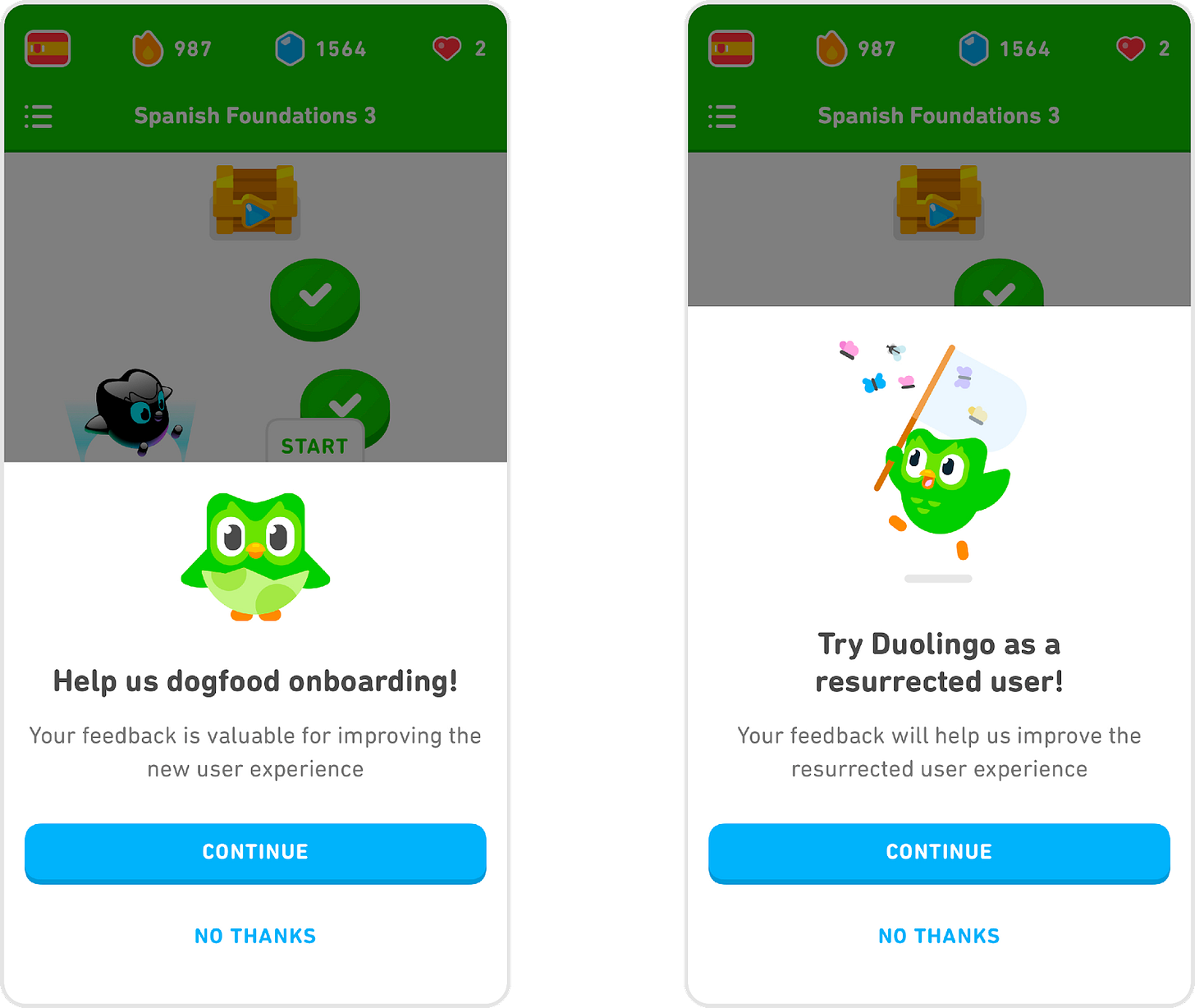How to create a culture of dogfooding
And why it's the most important thing you'll do this year
Happy New Year! New Year, new you amirite!? I spent a few hours over break reflecting on 2023 using this Figjam template (which you can copy and use - for free!). I know we set OKRs and goals for our jobs, but as a Builder, it’s helpful to do a similar exercise for yourself too. What do you want to accomplish in 2024 and how does that set you on a path to reach your longer-term goals? If you haven’t done this yet, don’t sweat it. January is a liminal month and you got time. Let me know if you need an accountability partner 👊🏻
Yours truly,
Nickey
—
Someone recently asked me why Duolingo has such an incredible product experience (in their words: “that continues to get better”) and my quick answer was pretty simple. Duolingo has a strong culture of dogfooding. They were surprised this was my answer, and while obviously there’s a lot more happening to continuously improve the product experience behind the scenes, dogfooding is the string that ties it all together. Ask any successful consumer-facing product person and there is a good chance they’ll say something similar. They use it, their work-peers use it, and they all collectively push to make it better every day through the experience of using it and talking about it.
It’s already well-accepted that there are many benefits from this practice. And yet, to bake this into the cultural fabric of your organization, this needs to be operationalized. Moving from “we should do this” to “we’re doing this” is always hard. Anytime something needs to be operationalized inside of an organization, there’s a chance that it just doesn’t come to life in the right way, it isn’t prioritized, or it falls over somewhere on the execution path. Here are my recommendations on how to operationalize dogfooding so it levels-up your product experience.
But first, what is dogfooding?
Before we get into the meat of this post (pun!), here’s a quick segue into dogfooding more generally. This term comes from an infamous 1970s commercial where Lorne Greene feeds his dog Alpo dog food. Ie. it’s good enough for HIS OWN dog. Until I wrote this post though, I assumed this meant he sampled his own dog’s food. This is so gross, but such a better metaphor 😜 File this under NOW YOU KNOW and here’s the actual commercial because I was feeling the nostalgia:
Dogfooding starts at the top
At Duolingo, we promote dogfooding at every turn at all levels of the organization. Duolingo’s CEO famously uses the product every morning, across different states and on different devices. He is often the first to catch when shit is broken and regularly reports bugs and issues with the experience because he’s using it every single day. This trickles down to his direct reports and theirs and profoundly impacts the organization’s behavior because it creates a shared baseline on the state of the product that allows the team to discuss current and future improvements easily.
At Airbnb, Brian Chesky invites guests into his own home as a host. Literally! This man is besties with Obama so I’m sure he runs a full CIA-grade background check on all his guests BUT STILL, this is not a thing he has to do. He does it because he understands the value and perspective it allows him to bring to his job.
At Etsy when I led the team working on the Seller Experience, I ran an Etsy shop. In fact, the majority of early Etsy employees ran Etsy shops. It was extremely time-consuming, but it gave me deep empathy for the struggle of getting to that first sale. It also helped me understand the administrative side of running a shop which directly impacted the work I did daily with my team. I’m also running a year-long streak on Duolingo because it helps me contribute in a more real way.
So TL;DR: start at the top and go down your organizational tree. Make sure your leadership team is using the product often, make sure the product team is using the product, and god-damn-it make sure even the intern is using it every day. If you don’t have influence over these groups at the very least make sure your team is using it, you’ll all be better for it.
Dogfooding is incentivized
While social pressure is an extremely effective tool, it’s not enough. Here’s another huge motivational lever you can pull: Pay people to do it. As I was preparing to write this post, I asked my LinkedIn followers how the companies they work for incentive dogfooding and here were some of the highlights:
Whatnot gives employees a monthly stipend to spend on the platform.
Airbnb gives everyone a quarterly stipend on Airbnb that you can use to stay on the platform (I miss this dearly!)
Etsy promotes Admin sellers internally and hosts Admin craft shows at their HQ.
Duolingo runs two yearly language learning challenges that offer financial incentives if you complete them.
And the list goes on!
Not everyone has the same 24-hours
This is as good a time as ever to remind you that not everyone has the same 24 hours. What does that mean? It means paying people to incentivize a behavior you’re looking for is a good way to make sure it happens. If you’re asking for people’s time, especially asking them to spend time doing it when it will sometimes fall outside of work hours, make sure that time is compensated. Or make sure it falls neatly into their workweek. Pay them for their labor, and said labor is more likely to happen.
Dogfooding is ritualized
Beyond tangible incentives, another way to motivate folks to use your product is to build company-wide rituals and programs that are staffed and supported for success. Here are some ways I’ve seen this done successfully at different organizations:
Build a program that runs at least a couple of times a year. Duolingo runs a bi-yearly program that incentivizes people to use the product every day. The program is run by a team of cross-functional leaders (engineers who build the platform, a technical program manager who coordinates program details across stakeholders, etc.). When the program launches it’s promoted to the entire company by leadership to drive participation.
Run a bug-bashing session. Before you ship something, get your team together to run through all the changes you’re making to “find all the bugs” (though you’re really just dogfooding what will be the new product experience). Make this a synchronous event and encourage people to share feedback out loud while you’re together. Keep tabs on the feedback shared and follow-up on it later.
Run an internal beta program. When a thing is built and you’re ready to get feedback from a wider set of people, release it to the company. Share that this is happening, how they can access it, and what kind of feedback you’re looking for. Promote it using org-wide communication channels (like all-team Slack channels, or company-wide all hands). Or better still, build into the product something that pushes people to use the product:

Read more about how Duolingo builds product here. Build tools that make dogfooding and reporting feedback low friction. Duolingo has something called “Shake to Report” which allows any admin to leave feedback that creates a JIRA ticket and gets reviewed by a real human. This makes reporting issues and feedback stupidly simple.
Make it fun. Don’t make this lame or people will hate you 🤭 When I worked on Duolingo Classes (which was sunset last year, RIP), we created a monthly dogfooding program where the team competed to take the most Classes and winners were both incentivized with money but also with custom emojis that you could only get if you won. Leaderboards didn’t hurt either.
Dogfooding is resourced
Finally, and most importantly, resource the work that enables more dogfooding. Things like building dogfooding programs, building tools that support said programs, creating larger more company-wide rituals all take people and time to bring to life. It takes a village, so don’t make this one person’s job or it’ll never get off the ground.
How do you dogfood?
Now, this is far far easier to do when what you’re building is easy to fit into your daily routine. But what do you do if it’s not a daily use case? How is this done where you work? What has motivated you to use your product more? Share your experience in the comments below 👇🏻
(Cover art by the talented Nika Polonskaya)






Great article. In my experience, in B2B it’s much harder to create such a culture, because it’s harder to use your product.
I work in AgTech, so to actually use our product in a meaningful way I need to own a farm 😅
We tried some creative ideas (like partnering with a farm near our offices, giving them the product for free so we could visit them in a mass and better understand how the product is used), but the fact is that still most employees don’t even understand the usage of the product.